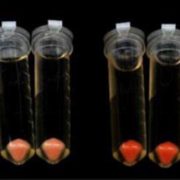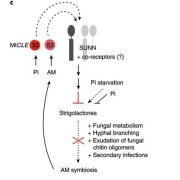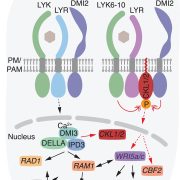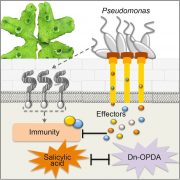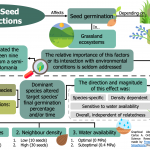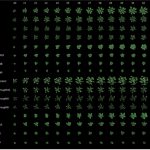Co‐catabolism of arginine and succinate drives symbiotic nitrogen fixation (Mol Sys Biol)
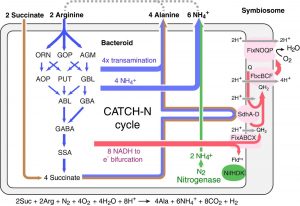 Symbiotic nitrogen fixation is a mutualistic relationship between plants and microbes in which plants supply fixed carbon to bacteria in exchange for nitrogen. During this process, the microbes use nitrogenase enzyme to convert atmospheric nitrogen into a plant-usable form, but the metabolic interaction between plants and microbes in maintaining this energy-intensive nitrogenase reaction remains an open question. In this paper, Tinoco et al. found that co-supply of both succinate (a carbon source) and arginine (a nitrogen source) are required to sustain the energy-intensive nitrogen fixation process. Co-feeding of succinate and arginine to isolated mature bacteroids of Bradyrhizobium diazoefficiens and Sinorrhizium meliloti increased the ATP levels and nitrogenase enzyme activity to a similar extent as providing the bacteroids with nodule crude extracts. To identify the pathway, the authors used isotope labeling and in planta transposon sequencing, in which a transposon-mutagenized pool of bacteria was introduced into plants and recovered after six weeks of in planta selection; genes underrepresented in the recovered sample are involved in symbiosis. These studies showed that arginine transport and catabolism are required during symbiosis, which was further validated using S. meliloti mutants impaired in arginine transport and catabolism. The authors named this newly identified metabolic pathway CATCH-N (C4‐dicarboxylate arginine transamination co‐catabolism under acidic (H+) conditions to fix nitrogen), and showed that the CATCH-N cycle delivers a 25% increase in nitrogen as well as promotes the survival of bacteria within the symbiosome. This cycle provides an important opportunity for engineering improved nitrogen-fixing symbiosis. (Summary by Sunita Pratak @psunita) Mol. Sys. Biol. 10.15252/msb.20199419
Symbiotic nitrogen fixation is a mutualistic relationship between plants and microbes in which plants supply fixed carbon to bacteria in exchange for nitrogen. During this process, the microbes use nitrogenase enzyme to convert atmospheric nitrogen into a plant-usable form, but the metabolic interaction between plants and microbes in maintaining this energy-intensive nitrogenase reaction remains an open question. In this paper, Tinoco et al. found that co-supply of both succinate (a carbon source) and arginine (a nitrogen source) are required to sustain the energy-intensive nitrogen fixation process. Co-feeding of succinate and arginine to isolated mature bacteroids of Bradyrhizobium diazoefficiens and Sinorrhizium meliloti increased the ATP levels and nitrogenase enzyme activity to a similar extent as providing the bacteroids with nodule crude extracts. To identify the pathway, the authors used isotope labeling and in planta transposon sequencing, in which a transposon-mutagenized pool of bacteria was introduced into plants and recovered after six weeks of in planta selection; genes underrepresented in the recovered sample are involved in symbiosis. These studies showed that arginine transport and catabolism are required during symbiosis, which was further validated using S. meliloti mutants impaired in arginine transport and catabolism. The authors named this newly identified metabolic pathway CATCH-N (C4‐dicarboxylate arginine transamination co‐catabolism under acidic (H+) conditions to fix nitrogen), and showed that the CATCH-N cycle delivers a 25% increase in nitrogen as well as promotes the survival of bacteria within the symbiosome. This cycle provides an important opportunity for engineering improved nitrogen-fixing symbiosis. (Summary by Sunita Pratak @psunita) Mol. Sys. Biol. 10.15252/msb.20199419


